On Translating Cultures, Culture Wars, and Censorship. A Conversation with Kim Levin

In 1992, three years after Communism fell in Poland, the legendary New York’s Village Voice art critic Kim Levin[1] organized TRANSLATION, an exhibition of American art at the Ujazdowski Castle Centre for Contemporary Art in Warsaw. Her local co-curator was Milada Ślizińska,[2] and the artists included Ashley Bickerton, Nayland Blake, Mark Dion, Kate Ericson and Mel Ziegler, Karen Kilimnik, Matthew McCaslin, Pruitt and Early, Haim Steinbach, Michael Timpson, and Fred Wilson.
Even though Levin selected different artists, the exhibition grew from Levin’s initial projects (1990) for the American part of an exhibition planned at the Tsaritsyno Museum. It was to bring to Moscow artists from UK, France, Germany, Switzerland, and the US, who would use ready-made industrially produced objects in their work. Due to the political situation in Moscow, the project was cancelled.
TRANSLATION was about an encounter of two cultures. The catalog includes a text by each artist and photographs of the realized installation and the curator’s essay, Levin writes: “What happens when artists who make object-oriented art come to a foreign land and express their visions through the subtly different universe of manufactured or crafted things they find there? What happens when outsiders, carrying the baggage of their own preconceptions, encounter a different culture?”
“TRANSLATION is also about “creative misunderstanding,” […] The aesthetic climate of Warsaw – a climate of minimality, conceptuality, and scarcity – gives an emphasis to the ingrained consumerist aspect of most of these works, with their accumulations of nails, tires, bottles, bulbs, pictures, animals, or cabbages. […] In Poland, social content in art has an unsavory past, and there is a revulsion against the former politicization of esthetic issues, and so these installations risk misinterpretation […] in the United States today, it is the Greenbergian ideology of purity, formalism, and newness that has become discredited.” – Kim Levin wrote in the catalogue.
Monika Fabijanska: The exhibition was originally planned for Russia; did you have any connection to Poland when you started working on it?
Kim Levin: Well, apart from the fact that my grandparents came from there a long time ago… I knew Anda [Rottenberg] through AICA. I went to Poland for the first time as a juror of the exhibition Europe Unknown she organized in 1991 in Krakow.[3] Before that, I went to Czechoslovakia in the summer of 1989, just before the Velvet Revolution, and it was fascinating; and then I went to the AICA convention in Moscow 2 weeks later.
I was teaching at a graduate art school in California where my student was the granddaughter of the last elected president of Czechoslovakia, Beneš. She teamed up with Zdenka Gabalovà, a curator in Prague, and organized a show which included half young Czech artists, half California artists from the school, and she wanted me to speak at the symposium.[4] The Czech curator had applied for the permission without being specific, so we weren’t there officially. When the secret service came to shut down the show, she would produce this permit. They were sitting in the back row during the symposium, listening. It was weird and very interesting. When I was interviewed by the daily newspaper, the reporter walked out of the interview. Zdenka had instructed me that as an American I could say whatever I wanted. It was the time of the Mapplethorpe and Serrano censorship controversies in Washington,[5] so I said something about that, adding “we have problems too,” and it was the “too” – the reporter just walked out. In the end we were all kicked out a week or two early because of the anniversary of Jan Palach self-immolation. I think they didn’t want any foreign visitors because it could have been another Tiananmen Square… So I came home thinking I must go to Moscow for the AICA conference. The conference was transferred to Tbilisi because there was no food in Moscow at the time. They took us in a military airplane to a town near Tbilisi, where we were for a week.
Was the idea of the TRANSLATION exhibition in Moscow born then?
It was the idea of Andrei Erofeev [from the Tsaritsyno Museum]. I don’t remember if he suggested it during the AICA congress, but eventually we were in contact – everyone used faxes in those days.
Speaking about faxes – the exchange between Haim Steinbach[6] and the Ujazdowski Castle staff, cited in the catalogue, is an example of an ideal challenge for an exhibition about translation between cultures. Just reading it, one can see they couldn’t build the cabinets the way he wanted.
Yes!
I imagine they couldn’t get him photographs of the space: copying and faxing would make them illegible; they could only draw and describe this hexagonal room for him. It is also obvious that Haim Steinbach was very peculiar about how he wanted his installation.
Oh, he was furious… Milada looked at me and said: take him to the milk bar for lunch. Do you remember the milk bars? With women cooking in the kitchen… That totally enchanted him. We had a wonderful lunch, which cost something like 75c, and his whole attitude about Poland changed. He also didn’t like that chamber pot…

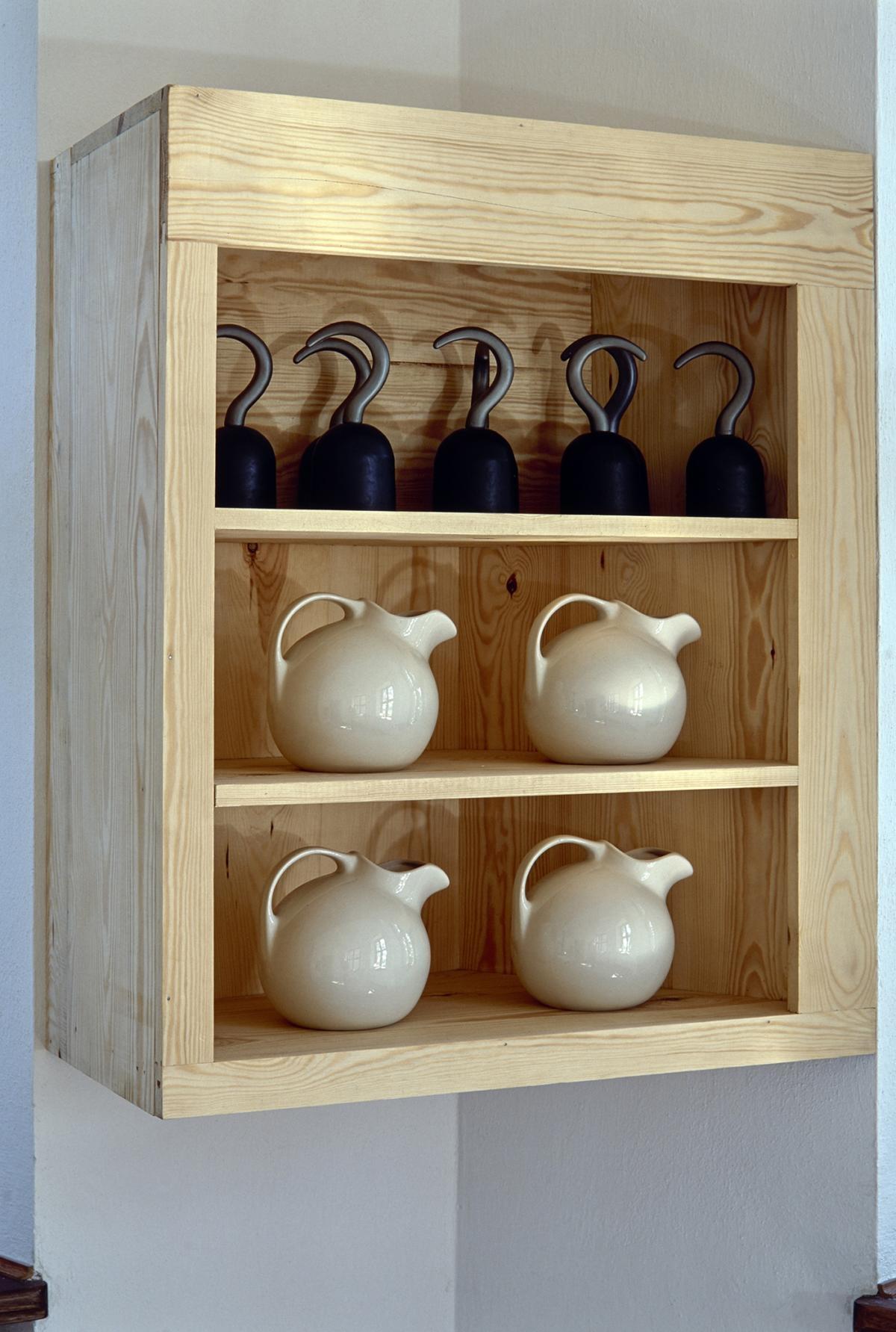
Those are the two misunderstandings highlighted by the catalogue: the fax exchange about cabinets’ shapes, dimensions and position, and then, the chamber pot. When an American wants a traditional chamber pot and you see the gold painted art deco object they gave him – it’s obviously not what he wanted.
He wanted a chamber pot because he thought his grandfather was persecuted by Poland or something, it was a symbol for him.
Then his installation had a personal side unlike, say, Fred Wilson’s. But whether they had personal relation to Poland or not, the works they created were a kind of anthropological or cultural excavation and I wonder – were they invited to come to Poland before the exhibition?
They were supposed to use Polish materials. Each one was given a Polish assistant, I guess a local art history student, and then there was this wonderful installation supervisor, Mr. Cezary Urbański. He was thrilled by all these strange things that he was asked to get. And he got them – everything that we asked for! He got champagne for the closing dinner and raised a toast: “Thank you so much for letting me do this. You have saved my life from boredom.” Isn’t that nice?
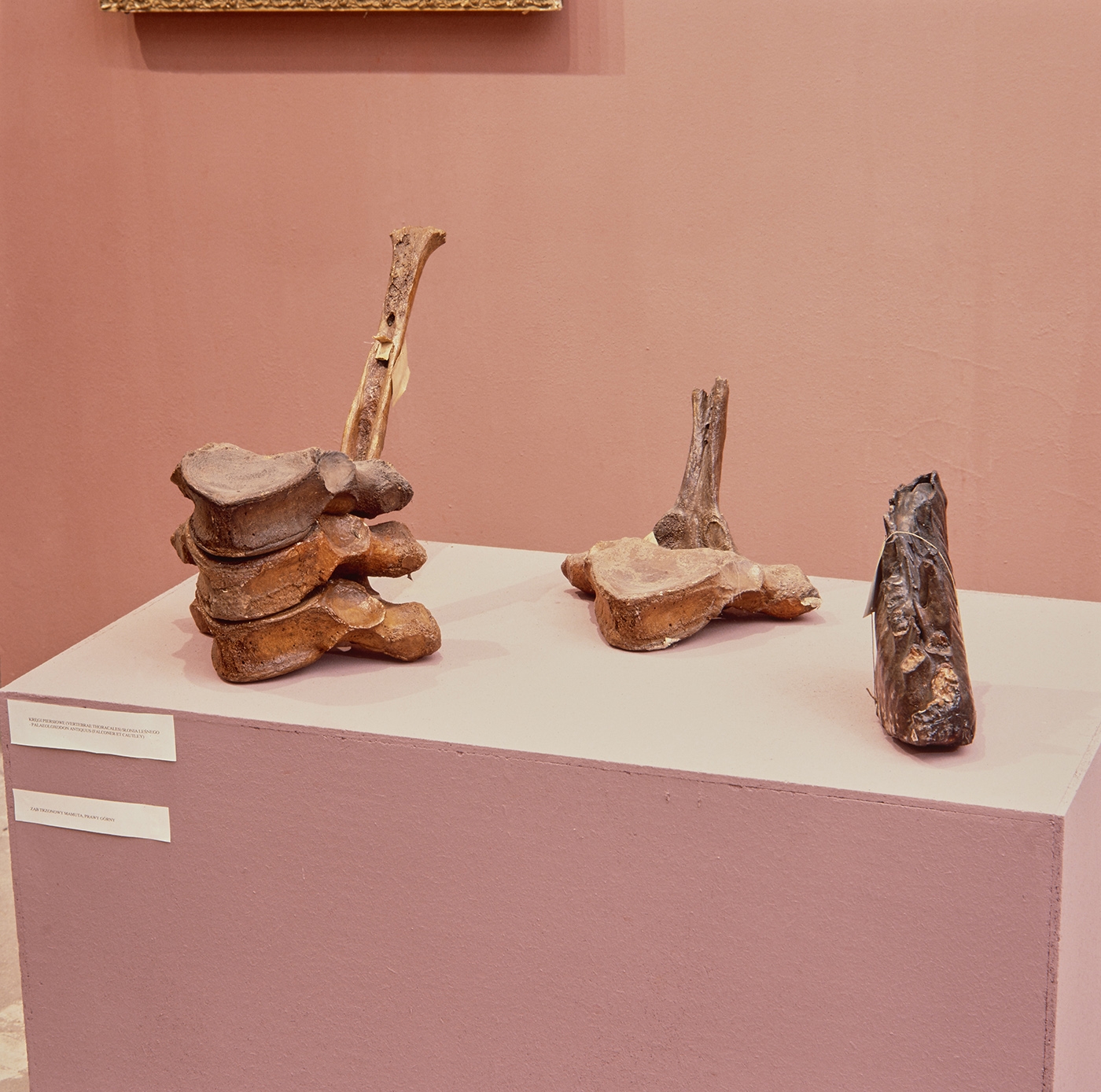
Fred Wilson, „Museum Impossible”, 1992, mixed media, installation detail. Photo: Mariusz Michalski & Barbara Wójcik. Courtesy of the artist and the Centre of Contemporary Art Zamek Ujazdowski
So they were supposed to use Polish materials and translate their expectations of the other culture through foreign material?
They were artists who used bought or found materials to create socially engaged art which was unusual for this country at that time. Most of them came to Poland with nothing but the idea. I don’t know if some of them even had an idea until they saw the Castle.
From Haim Steinbach’s faxed instructions, it looks like he never came before the opening of the show. He had his idea executed for him.
He decided not to come to Poland. He finally came for 24 hours, only after he figured everything had gone wrong, to correct it. He was the only one who brought anything to the show: these mugs in the shape of breasts. Nobody else brought anything. The other artists all came before the exhibition and they developed their installations on site.
Fred Wilson had no connection to Poland – did he arrive and develop his idea there?
I think so. And Nayland Blake7 also – he developed his idea in Poland.
It is very interesting that he used folk figures of Jews; I would expect Fred Wilson to do that.
Why? Nayland Blake had black father and Jewish mother.
So there was something personal about that. The reason why I thought of Fred Wilson was a long conversation I had years ago with an American Consul in Krakow who was an American Jew and who had very emotional relation to Poland which was kind of love-hate. He was also very new – he just arrived. We met at the annual Jewish Culture Festival, and he kept telling me until he was red in the face that it was all bullshit and its only result was that there were more and more of these folk figures of a Jew with a coin sold as souvenirs. It’s not that I wanted to deny the problem. But I wanted to somehow get across a message that would open him to other possibilities of thinking about the Festival, and I suddenly remembered Fred Wilson’s works! I asked: “Have you ever travelled to South Carolina? Have you seen all those figurines of Black Mamas?” And he lost speech. He suddenly realized that we’re not all that different.
The radio program I was invited to speak about the exhibition created such an outcry about them: “Why did he bring these horrible little figures to Poland”? I said: “He didn’t bring them, he found them in the markets.” They didn’t believe me. I mean they just hadn’t seen them, they didn’t register…
Also, they were not yet as ubiquitous as they are today.
It was just the beginning of them, I think.
It was the beginning of tourism. This is important because Nayland Blake writes about his work in the catalogue precisely in the context of tourism.[8]
And it is so weird, because they’re mostly produced for Jewish tourists.
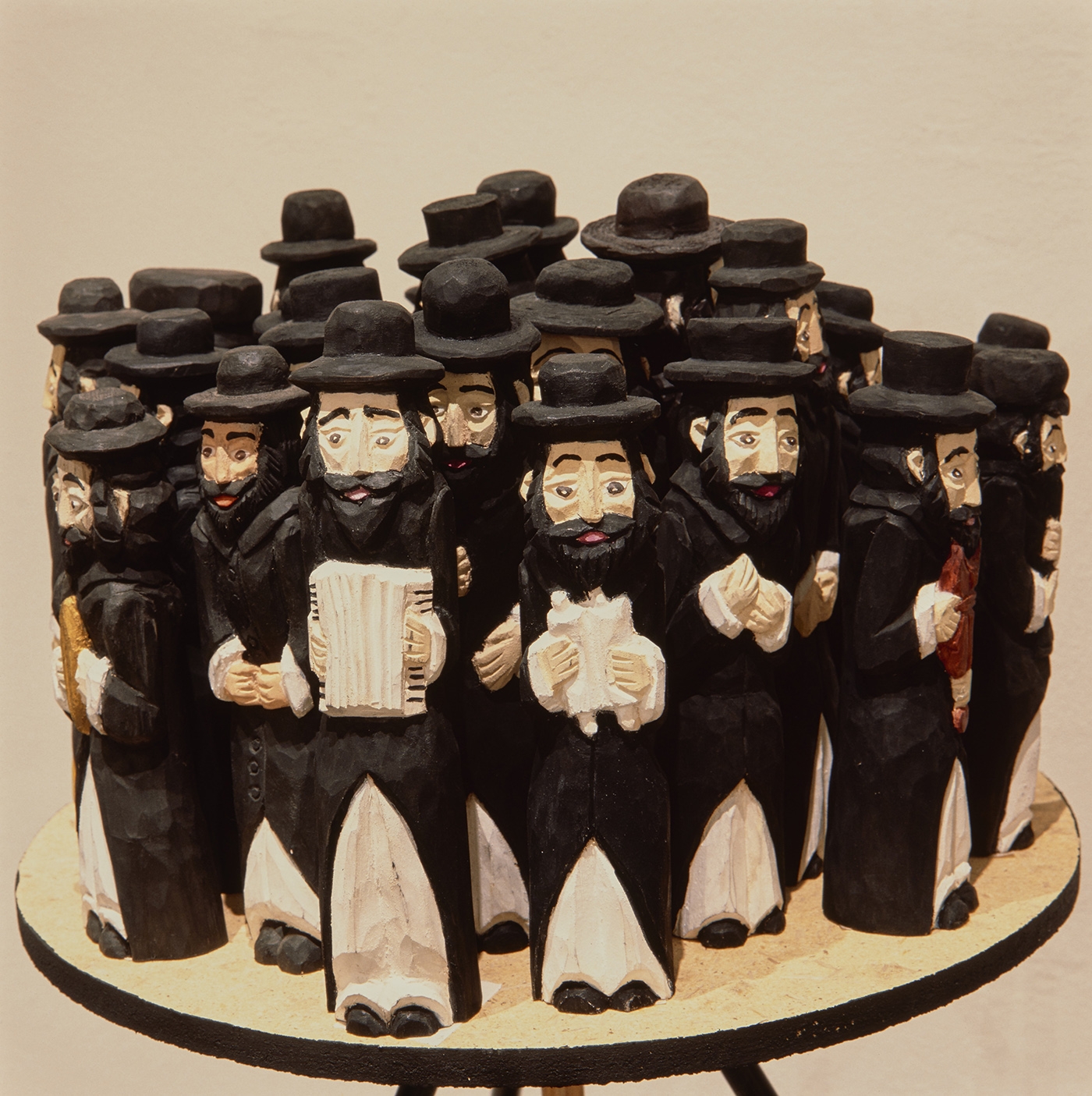
Nayland Blake, “Handicraft”, 1992, mixed media,
installation detail. Photo: Mariusz Michalski &
Barbara Wójcik. Courtesy of the artist and the
Centre of Contemporary Art Zamek Ujazdowski
This is the devilish side of it.
We just don’t see such things – even when they’re in our face – until a controversy brings them up.
We talked about individual artists’ choices, but I would first like to understand how the idea for the exhibition came together. Why did you choose these particular artists?
This was practical, in part. I had the list of artists, when the [Ujazdowski] Castle lost its funding just before the show because the government changed. There had been a symposium at the Metropolitan Museum in New York, where I met Richard Lanier.[9] They invited people representing many institutions to discuss how we reorganize Eastern Europe now that it is free: people from art libraries, museums, and also two freelance curators. I was one of them. And all the talk was we have to get them on the Dewey Decimal System! That’s how libraries here were organized: it was a series of file cards, cross-referenced by author and by subject. What makes you think that our system is any better than their system? Maybe we should find out what system they’re using?
It is a version of imperial dream I never heard of.
And totally unconscious. So that’s how I met Richard Lanier, then Milada told me we lost all the funding, and I called him up and two weeks later I had a check for 14,000 dollars. It was enough to organize an exhibition in Poland then. Milada went to LOT Polish Airlines and we got enough free tickets to bring all the artists.
How was your choice of artists related to funding? And what informed it? These are installation artists, except for Karen Kilimnik who changed her medium over the years. Were these the artists of the day, or were you guided by the idea that using materials specific to local culture one can communicate and translate from one culture to another?
The idea. The subject had already been called TRANSLATION, it was Erofeev’s idea of translating cultures. I was planning socially engaged works for that show, where artists were to use ready-made locally produced objects. When it was cancelled, Milada – during her stay in New York at the turn of 1990 and 1991 – proposed that we do that in Warsaw. I don’t think I made the final list for Russia, but then I chose the artists for Warsaw. I had a list of ten or twelve artists and then documenta announced their artists. They were to open two weeks before our exhibition and half of the artists I had chosen were in documenta: David Hammons, Jimmie Durham, at least five or six of them. documenta had an incredibly big budget and I also thought that artists would be tired: they would have just finished installing there. So I chose the next generation. The only one I kept was Haim Steinbach – because Milada really liked his work. It gave exposure to younger artists and it made it easier, too. I think we had 500 dollars per artist in the budget, of the money Richard Lanier gave us. These artists were not known at the time. In fact, I have a feeling that the Castle wanted to cancel the show when I sent my list of artists. But then I proved that they’ve all shown elsewhere, and it was OK.
A German museum director came to see the show and he asked how I knew all these artists and how I knew I could work with them. I didn’t know any of them before – I met them in Poland. I chose them by their work, by their shows in NYC galleries.
Indeed, most of the exhibition documentation in the Castle’s archive consists of your faxes with their lists of exhibitions. I’m impressed that you picked Mark Dion and Fred Wilson so early. 25 years later, so many of your artists are stars. And exoticism of the art of Wilson or Ashley Bickerton[10] in Poland at that time was considerable.
Karen Kilimnik[11] was also at the very beginning of her career. Her installation was wonderful. But… we totally misunderstood what kind of horse and carriage she wanted.

Ashley Bickerton, „Exit: Warsaw”, 1992: photo
wallpaper, a raft with a tent, ropes, flashing light.
Photo: Mariusz Michalski & Barbara Wójcik.
Courtesy of the artist, Lehmann Maupin Gallery, New York, and Centre of Contemporary Art Zamek Ujazdowski
Like with the chamber pot!
Somebody went to the Old Town and found a horse and carriage.
And she wanted a palace one.
Exactly, she wanted a fairy tale one.
I thought hers was a political work about class.
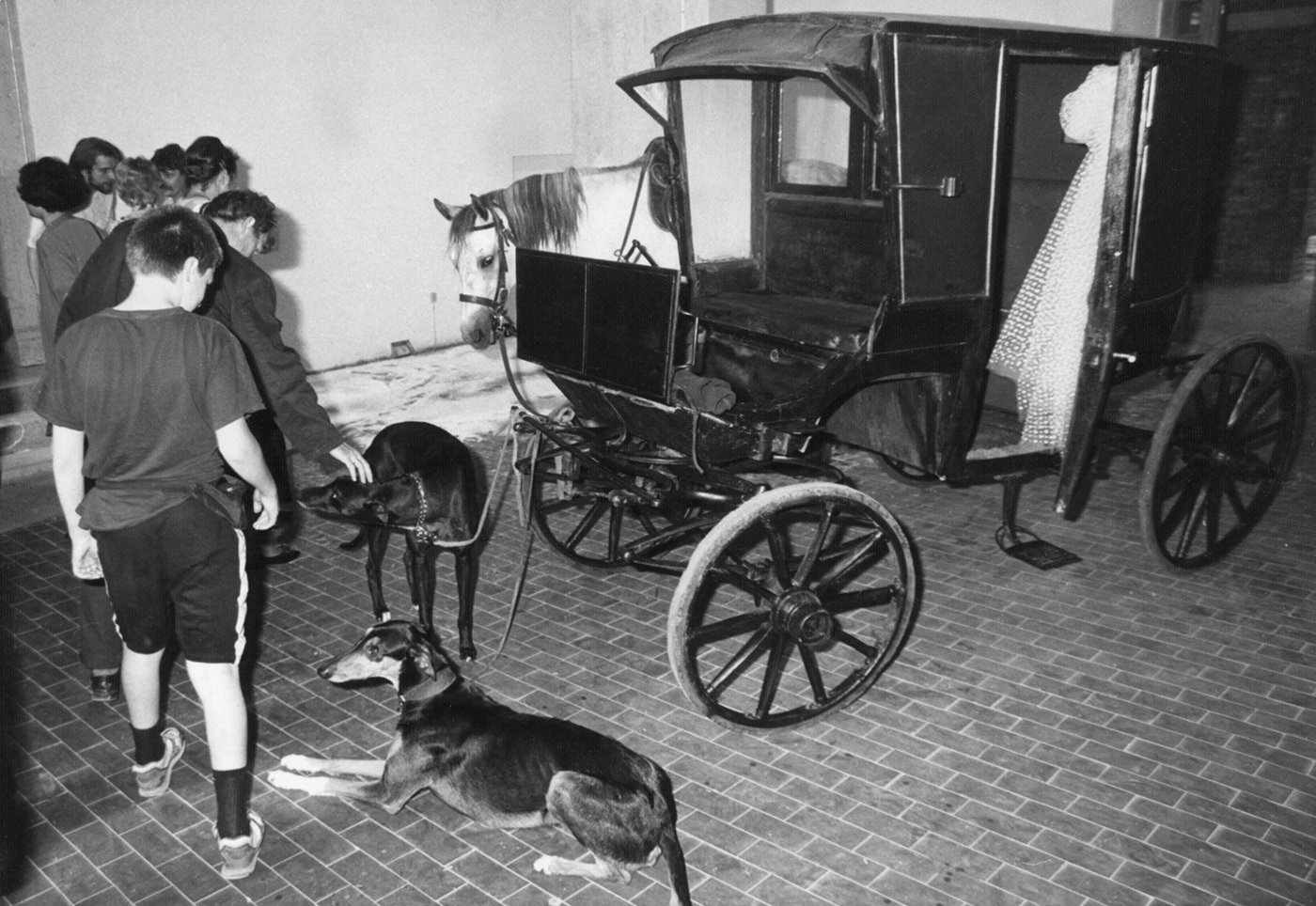
Karen Kilimnik, „Untitled”, 1992, mixed media.
Photo: Mariusz Michalski & Barbara Wójcik.
Courtesy of the artist and the Centre of
Contemporary Art Zamek Ujazdowski
It was about class. But she did that partly through teenage fantasy, fairy tale.
You mentioned women’s participation, but your exhibition also had mostly men… There’s Karen…
And Kate Ericson… And otherwise it’s all male! (surprised)
A German museum director came to see the show and he asked how I knew all these artists and how I knew I could work with them. I didn’t know any of them before – I met them in Poland. I chose them by their work, by their shows in NYC galleries. Pruitt and Early had just been involved in a big scandal and I had to consider whether to take them out of the show or not. They had just gotten with Castelli, they were just making it. And their show at Castelli got slammed in the press. They were known for works about adolescent male American culture, and they did this show with objects taken from the culture of the black American youth, and because they were both Southerners it ruined their reputation. Nobody would show them, my exhibition may have been their last show together.
I was wondering if you knew Ryszard Waśko when he was artistic director of P.S.1 in New York, 1990-1992? Your choice was independent from the Construction in Process’ milieu of minimalist artists. There is no connection between what you did and what they were doing.
No, absolutely not. But I have been to Construction in Process. I went to two events in Poland.
Then your exhibition presented unknown art from America. How was it received in Warsaw?
It was very controversial. For one thing, Nayland Blake’s figures. Fred Wilson’s[12] theme was very controversial. He borrowed dinosaur bones from the Museum of the Evolution, devils from the Museum of Polish Devil, and socialist realist works from the storage of the museum of revolution.[13] I don’t think he knew about it and I didn’t either, until someone asked why he was outing these dissident artists. Most of the works he chose were student works by artists who later were considered independent. He wasn’t doing this deliberately; he just had an artist’s eye. And the whole idea that it was socially oriented art was controversial. At least when I was there, they really had trouble distinguishing it from the state sponsored social art.
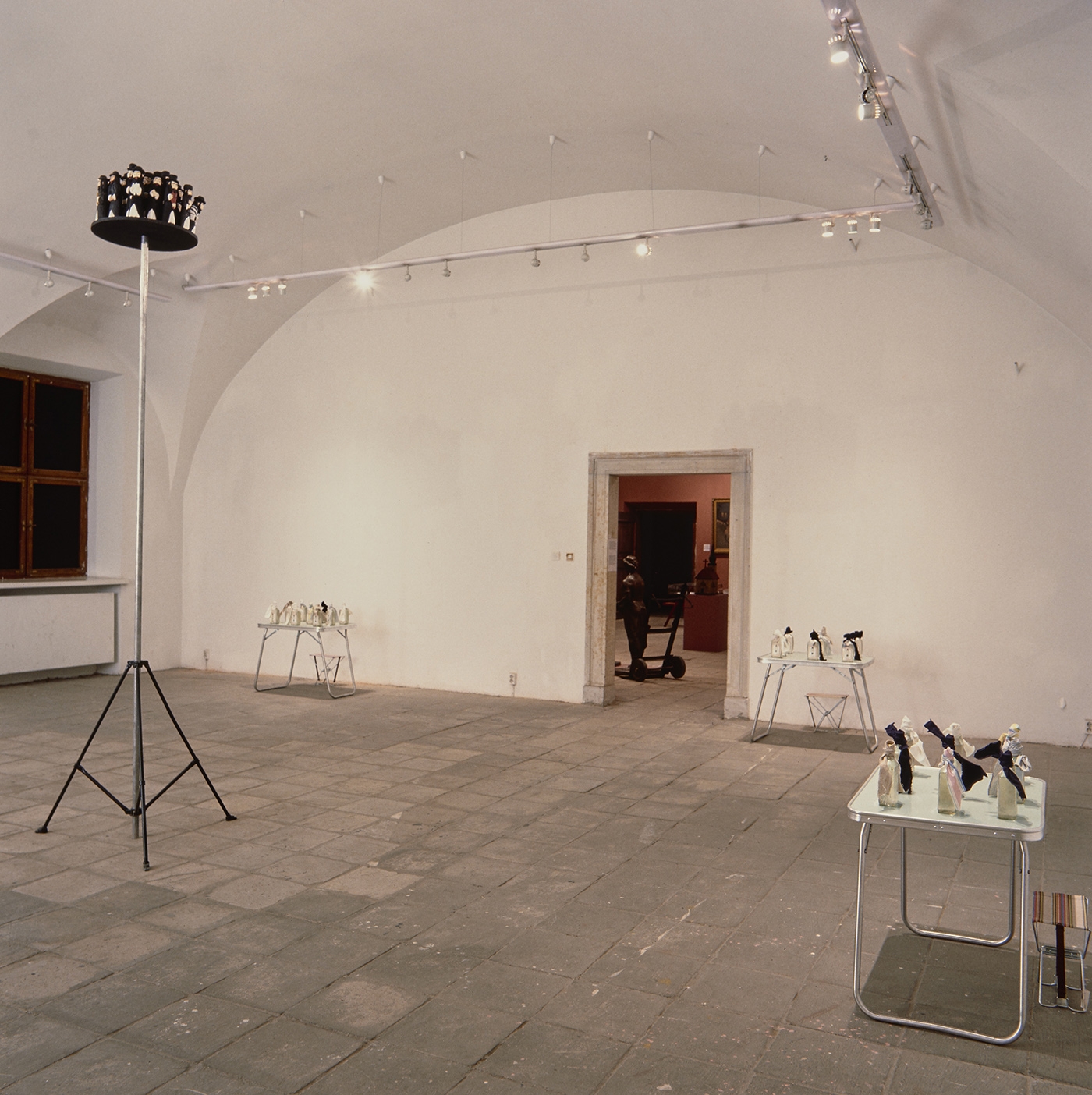
Nayland Blake, „Handicraft”, 1992, mixed media.
Photo: Mariusz Michalski & Barbara Wójcik.
Courtesy of the artist and the Centre of
Contemporary Art Zamek Ujazdowski
Because for you it was already appealing, while we were just shedding the costume of socialism.
Exactly. I kept hearing, “we have seen this before, why are you bringing it back to us” and I had to explain that it was not government sanctioned art, it was protest art.
I was happy with the show. I think they all did good work. It’s not work that is well known here because the catalogue didn’t come till later and it was never distributed in this country, but I was very pleased with the exhibition.
Whose paintings did Fred Wilson pick up? He hanged them upside down… Is there a document? I didn’t find it in the Castle’s archive.
I don’t have it. It was all improvised. He just picked a few works from their stacks and they gave them to him. I don’t know if there were loan forms or anything. And Mark Dion’s stuffed animals similarly…[14] they gave them to him. Can you imagine the New York’s Museum of Natural History lending the extinct animals for Mark’s installation? No. A lot of these things wouldn’t be possible here. And then we had no idea how to transport them, so probably Mr. Urbański got us an army truck, and everybody donated hotel blankets from their hotel rooms to wrap them in. It’s sort of beyond belief that that could happen… but they all survived and went back.
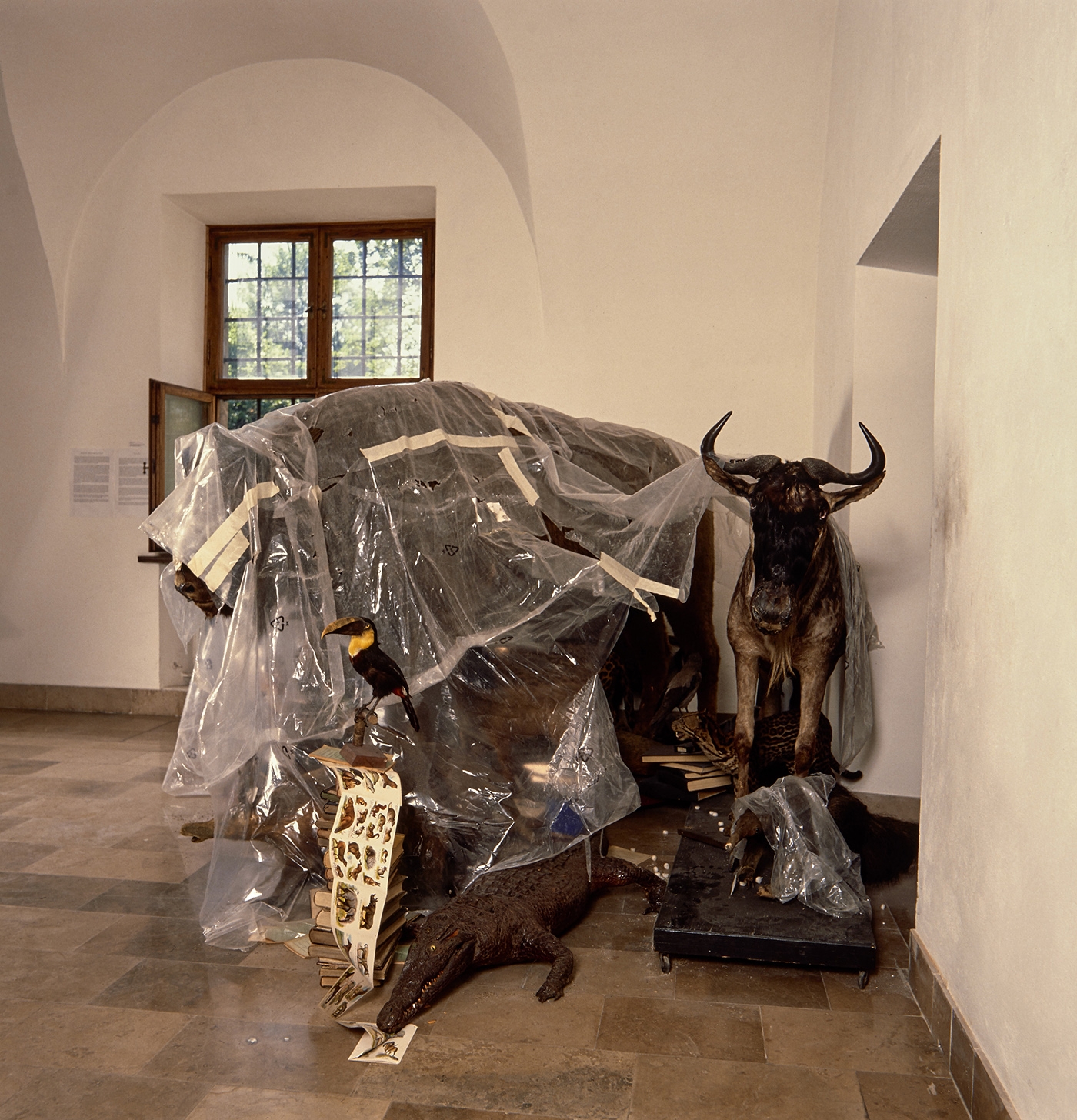
Mark Dion, „An Account of Six Disastrous Years in
the Library Fair”, 1992, mixed media. Photo:
Mariusz Michalski & Barbara Wójcik. Courtesy of
the artist, Tanya Bonakdar Gallery, New York,
and the Centre of Contemporary Art Zamek
Ujazdowski
I almost believed the story about Professor Stefan Jeżyk he made up! It is so well done and it is such an interesting take on local history.
What in the exhibition didn’t work – from any perspective: either curatorial or institutional?
Well….. (a long pause) I think it was wonderful. We couldn’t afford for the horse and the dogs to be there for the duration of the exhibition in Karen Kilimnik’s installation, but for a few days after the opening only. The installation stayed, it just didn’t have live animals. That was really disappointing, but it was the budget, it wasn’t anybody’s fault.
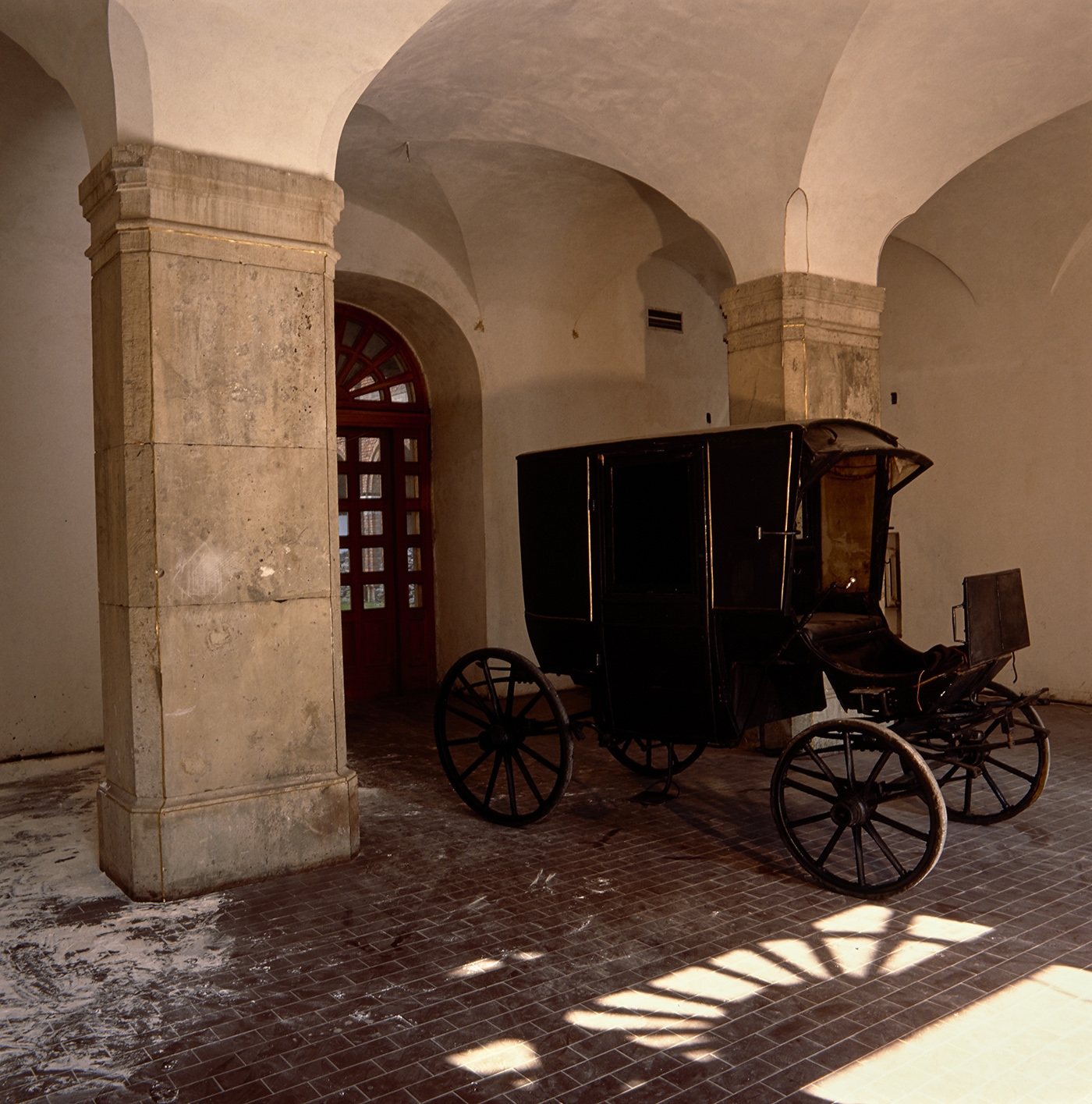
Karen Kilimnik, „Untitled”, 1992, mixed media.
Photo: Mariusz Michalski & Barbara Wójcik.
Courtesy of the artist and the Centre of
Contemporary Art Zamek Ujazdowski
How was it to work with Milada?
I loved working with Milada. She was wonderful! She was fierce and it allowed me to be fierce in my own way. It was a great collaboration.
Did the idea of translation, of meeting of two cultures, work in your opinion?
In some of the artworks it worked, some were seamless, for example Pruitt and Early[15] found everything in Warsaw for their installation that they would find in New York. So it was almost like not a translation. And does that make it better or does that make it worse? I don’t know.
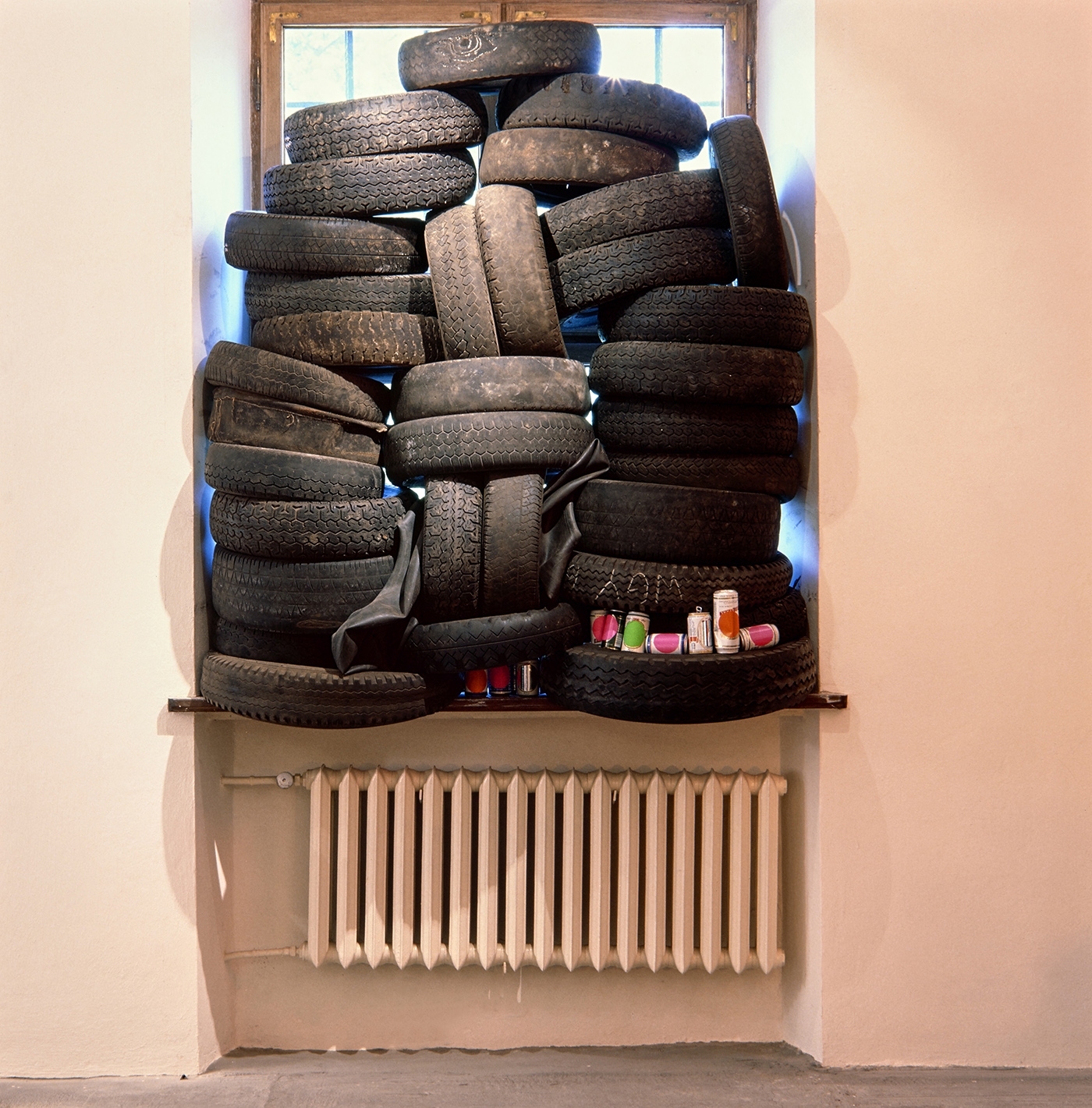
Pruitt and Early, „Unplugged in Warsaw”, 1992,
mixed media, installation detail. Photo Mariusz
Michalski & Barbara Wójcik. Courtesy of the
artists and the Centre of Contemporary Art
Zamek Ujazdowski
How utopian was the idea of translation, how right or wrong you think the artists were?
It doesn’t really matter. I was happy with the show. I think they all did good work. It’s not work that is well known here because the catalogue didn’t come till later and it was never distributed in this country, but I was very pleased with the exhibition.
Did you think that the audience understood the point of the exhibition?
I wasn’t sent the articles. It would be interesting to know.
I found press clippings in the Castle’s archive and the reviews were mixed. It seems that audience had problems understanding the exhibition, especially the use of Duchampian ready-mades,[16] and accepting those works which had direct references to Polish culture or history (Blake’s, Wilson’s, Dion’s).
The Voice, published in English, had the most enthusiastic review, because Lucy Kimbell simply understood the exhibition: “the physicality of the work […] bodes well for America’s interpretation of the post-communist world. One hopes that the reverse is possible here too, before the throwaway culture is fully translated to Poland.”[17]Życie Warszawy review was excellent and pointed that „the essence of these actions is translation of the idea […] of an artist into the language of objects, especially in the relation to the specifics of the place. This last premise consciously touched an important and painful problem of our own art which is entanglement with ideology, even if from a position of protest.”[18]
Gazeta Wyborcza critic took it personally: “critique made from the position of a tourist is by definition superficial and banal.”[19] Interviewing you for Życie Warszawy, Marek Bartelik mentioned that Blake and Dion were accused of being anti-Polish, and said: “The most appreciated were these works that had the least direct references to Polish reality. For example Haim Steinbach’s installation, in which he used American mass culture objects. Maybe you should have brought more works about Americans?,” to which you responded: “But all the artists speak about America, and their works are typically American!”[20]
Nobody likes to be criticized by a guest…
What drives projects like this is the curiosity of the other, and even if you repeat a few stereotypes on the way, you still learn something, on both sides.
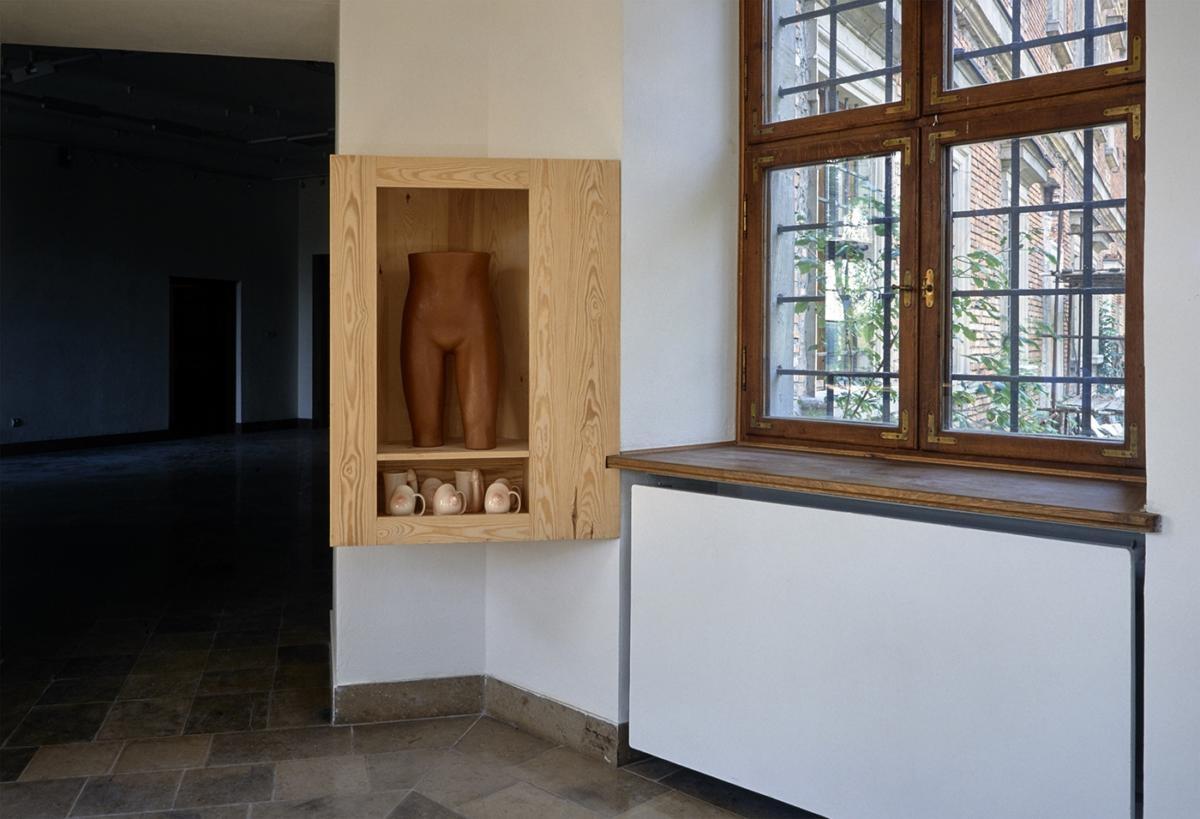
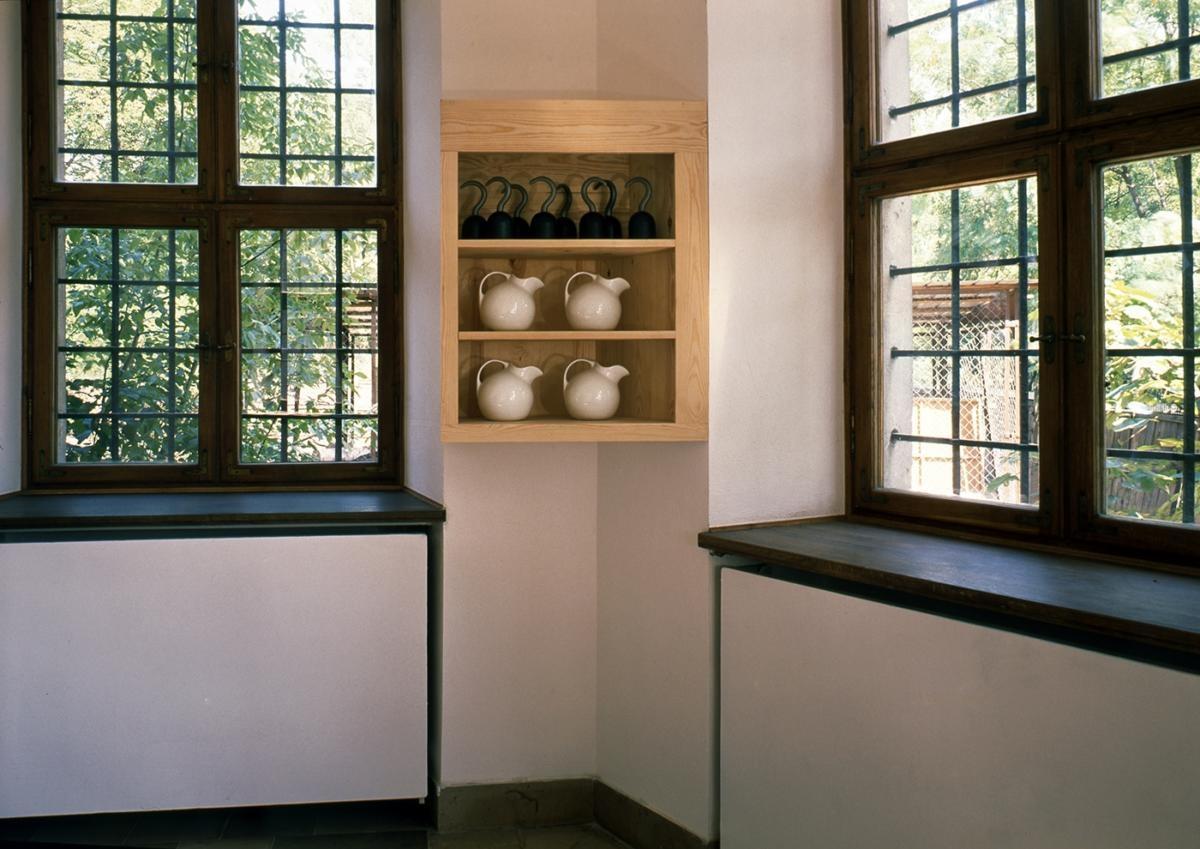
In your catalogue essay you wrote about globalism and other issues that we are aware of today, but Poland was at the moment of frenzied joy of shedding Communism. The society was not ready for a critique of capitalism.
…adopting neoliberal economy without questioning it…
You also wrote that it was the moment of changing guard in America: from purist art, from the traditions of abstraction and minimalism, to art that was more socially engaged.
The change here happened through the feminism and through AIDS: all the artists were dying and nobody was paying any attention. Art became social. Nobody believed in minimalism anymore, modernism was used up.
The scene is totally divided now. There is the Jeff Koons’… branch of art, and there are some very good artists around who haven’t got much attention, even if they’re written about…
Would you agree that it became very conservative again?
Yes, exactly. I think I wrote a short article for the Voice about it, that the clouds of censorship were already moving West with the Mapplethorpe and Serrano controversies, with the director of Contemporary Art Center in Cincinnati on trial for showing Mapplethorpe. This was incredible.
Do you see artists in America continuing their social engagement?
Some. The scene is totally divided now. There is the Jeff Koons’… branch of art, and there are some very good artists around who haven’t got much attention, even if they’re written about… William Pope L. is just beginning to be in the big shows, Trevor Paglen, and Daniel Joseph Martinez – he’s very radical.
Were you organizing an exhibition like that today, whom would you choose?
The three I just mentioned to start with.
So you would still choose artists who represent social concern. But then, was there ever an idea that this exhibition should be somewhat representative of America?
But it was! I mean our culture is very consumerist. People were minimalist in Poland then. The accumulation of objects gathered in the exhibition was a shock for the audience.
Where did this show stand in relation to other international exhibitions you organized?
The one in Korea[21] was first and I had no idea what I was doing when I started. Leo Castelli agreed to preside over the show, but when I asked to borrow artworks from him, he gave me Warhol’s Brillo Boxes which were multiple. He didn’t give me any other work, I got them all from collectors. And he told me: “It’s impossible to organize a show like that in 7 weeks. I can give you prints by all the artists, they will never know the difference,” I said “Thank you very much but I am going to try.” I brought him the catalogue when we came back and he was amazed.
There was even a catalogue for a show organized within 7 weeks!
My fellow curator at the museum there was up all night translating the catalogue, asking me questions like what postmodernism meant – they didn’t have a word for it and we had to figure out how we should say that.
So this was a true experiment in translation, probably much more difficult than the one with Poland.
But Poland and Norway were comparable. The one after Poland – in 1993 in Norway was an AIDS show.[22] It could have never been done in this country – I would have loved to bring it here. In Norway they had no problem. This show travelled and there was an educational program. They brought school kids to see it and they had a big plaque with fake penises on it and condoms to teach children how to put them on.
But each of my shows had one jinxed artwork or artist – and in Norway it was Felix Gonzalez-Torres. I got one of his corners with the candies. None of us knew that Norway had a law against importing sugar candies! Finally, we got them made locally, wrapped in the same color. But the candies didn’t appear until after the opening. We also had a billboard with the unmade bed. They put it in front of the museum, but there was an old-age home across the street and the residents got very upset. They demanded that we remove it so we moved it somewhere else, but I thought it was sort of wonderful that they actually realized what it was about.
It is very interesting what can become controversial. I had two issues in the US – one of them with the exhibition of Polish art at the Real Art Ways in Hartford, CT, where I recommended Marek Bartelik as curator and then helped produce the show. The work he chose by Karolina Breguła was one in a series of billboards of both male and female gay couples holding hands in a sort of self-outing. They had been allowed in the streets in Poland in 2003 but censored in Hartford, CT.
Not in Poland?
Not in Poland. In 2006, Hartford, CT, didn’t allow such a billboard in public space. There was even a story in The New York Times.
It’s incredible.
You can never be sure which society is more conservative, which system would allow what.
Eventually curating became more important, more interesting for you than writing. Why?
You’re dealing with people, with reactions in different places.
It is an interesting consequence of your first three shows – that you kept curating abroad.
I enjoyed this disruption. My show in Korea went to Japan. And I had two Jasper Johns and four Rauschenbergs in it, each needed a wall or half a wall at least. In Japan they wanted to hang them all on one wall, very close together. We got into a discussion about it and apparently, in Japan, if the works are arranged close together they think the show is more important because there’s more in it. And then, they also told me that I was hanging them all too high: “you’re forgetting that you’re the height of a man”. Totally unexpected!
Did you meet any interesting Polish artists?
Yes. I went to visit Mirosław Bałka, Joanna Przybyła… I went to Białystok and visited Leon Tarasewicz. My mother’s family came from Białystok. It was just before they tore down the old wooden buildings, so I was very glad I could still see them. And a local historian told me how come in the Białystok family of my mother there was a Chinese man, my great grandfather…
Which generation immigrated to America?
My grandfather. He came in 1880s. We had family in Białystok, Russian Orthodox, they stayed there, except for my grandfather who came here at the age of 12.
And your father’s family?
My father’s family came from Suwałki in 1860 – just before the Civil War.
So my first question to you could have just as well be the last one.
Monika Fabijańska is an art historian, independent art curator, producer and artist representative based in New York City. She holds MA degree in Art History from the University of Warsaw.
The magazine is not able to publish the photographs of Fred Wilson’s entire installation, in which he used works by other artists, because of the lack of rights to use the images of those works. The photographs can be seen in the catalog of the exhibition: TRANSLATION, CCA Ujazdowski Castle, Warsaw, 1992.
[1] Kim Levin is an American art critic and writer. She was a regular contributor to The Village Voice from 1982-2006. Since 2007 she has been contributing regularly to ArtNews. Levin worked as a correspondent for Opus International, 1973-1977; a correspondent at Flash Art, 1980-1994; and was a contributing editor for Arts Magazine, 1973-1992. She was AICA-USA (Association international des critiques d’art) Treasurer, 1982-1984; Vice President, 1984-1990; and President, 1990-1992. She became Vice President of AICA International in 1991 and was its President 1996-2002. An installation of notes Levin jotted down on press releases and gallery announcements, appeared in the solo exhibition Notes and Itineraries at Delta Axis, Memphis (2002); Ronald Feldman Fine Arts, New York (2006), and traveled internationally to Haas & Meyer, Zurich (2006), Ludwig Museum, Budapest (2007), KIASMA, Helsinki (2008), and was included in the group show Retracing Exhibitions at the Royal College of Art, London (2009). She has lectured and curated internationally.
[2] Milada Ślizińska is Polish art historian and curator. She received her MA in History of Art from the University of Warsaw. She worked at the original Foksal Gallery from 1972 to 1987, was director of the Exhibitions Department at the Institute of Industrial Design, 1987-1989, and from 1990 to 2011 was chief curator of the International Exhibitions Program at the Centre of Contemporary Art „Zamek Ujazdowski” in Warsaw. There, after the fall of Communism, Ślizińska curated solo exhibitions of Marina Abramovic, Christian Boltanski, Nan Goldin, Jenny Holzer, Ilya Kabakov, Joseph Kosuth, Shirin Neshat, Gerhard Richter, Pipilotti Rist, Cindy Sherman, Rosemarie Trockel, James Turrell and Kara Walker, as well as Polish arists: Magdalena Abakanowicz, Wojciech Fangor, Leon Tarasewicz, Krzysztof Wodiczko, et al. In 2014 she curated the retrospective of Teresa Żarnowerówna at the Muzeum Sztuki in Łódź. Currently, she teaches at the Academy of Fine Arts and at the Fryderyk Chopin University of Music in Warsaw. She lectured at the Royal College of Art, Columbia University, New School, and Bard College.
[3] A juried exhibition, organized under the patronage of UNESCO, AICA, and Polish government, with works submitted from all “the other side of Europe”, including Turkey. There were five jurors. The initial selection was made by three Polish jurors: Wiesław Borowski, Anda Rottenberg, Aleksander Wojciechowski. The final selection was made by Kim Levin and Evgeni Barabanow from Moscow.
[4] The exhibition Dialogue: Prague-Los Angeles curated by Zdenka Gabalovà and Barbara Benish was presented at the Lidovy Dom in Prague in August 1989 and traveled to the Parsons Gallery in Los Angeles in 1990. Gabalovà then became a curator at PS1, and she later served as Consul General for the Czech Consulate in Los Angeles. She died young.
[5] In 1989, Robert Mapplethorpe’s traveling solo exhibit brought national attention to the issues of public funding for the arts and censorship. The show was curated at ICA in Philadelphia which was awarded a grant from the National Endowment for the Arts to support the exhibit and its tour. The Corcoran Gallery of Art in Washington, which had agreed to be one of the hosts, cancelled the show when its hierarchy and several US Congress members became upset by the homoerotic and sadomasochistic themes of some of the works. In 1990, the Contemporary Arts Center in Cincinnati and its director Dennis Barrie were charged with obscenity. They were found not guilty by a jury.
In many of Andres Serrano’s photographs, objects are submerged in bodily fluids: blood, menstrual blood, semen, or human breast milk. Piss Christ (1987), a photograph of a plastic crucifix submerged in a glass of the artist’s own urine, caused great controversy when first exhibited. Serrano, alongside artists such as Robert Mapplethorpe or Barbara DeGenevieve were attacked by Senators Jesse Helms and Alfonse D’Amato and other cultural conservatives for producing offensive art.
[6] Haim Steinbach’s installation consisted of three cabinets installed at different heights in the corners between the windows in hexagonal tower room, and made of wood according to his instructions sent by fax. In them were placed a display torso, mugs in the shape of breasts and mugs with a handle in the shape of penises, some pitchers and Captain Hook prosthesis, and a 1920’s chamber pot with decoration painted in gold.
[7] Nayland Blake’s installation consisted of four folding tables with Goldwasser vodka and folk wood figurines of Jews.
[8] “I live in a town that survives on tourism. The effects of this economic decision are many and they color all the facets of one’s daily life. […] Eastern Europe now faces the West with ambiguous desires and opportunities. Will it make history and life in its own image or will it choose to live inside of a representation of itself, tailored to others’ ideas and desires?,” Nayland Blake, in: Translation, CCA Ujazdowski Castle, Warsaw, 1992 (June 26-August 1).
[9] Richard Lanier, founding trustee and long-time President of the Trust for Mutual Understanding, the only American foundation to support cultural and environmental exchanges between the US and Russia and other Eastern and Central European countries.
[10] Ashley Bickerton’s installation had walls painted black, photograph wallpaper with a tropical landscape, and an orange raft with tent filled with cabbage.
[11] Karen Kilimnik’s installation consisted of a palace style coach with a horse and two greyhounds, gold paint decoration on the walls, fake snow, brooms, and a slideshow.
[12] Fred Wilson’s installation presented itself as a fake museum display with socialist realist sculptures and paintings hanged upside down, dinosaur bones, folk devil figures, and sound: a voice reciting a litany of things that can’t possibly be done coming from a wooden church model.
[13] The Museum of the History of Polish Independence and Social Movements in Warsaw (now Museum of Independence) was established in 1990 in the Przebendowski Palace, which had previously housed the Museum of Vladimir Lenin (1955-1989). Its storage, historical collection, and library were in a pavilion near Ujazdowski Castle until 1993.
[14] Mark Dion’s installation consisted of the stuffed wild animals from the Museum of Evolution collection, books, and an accompanying text – a fictitious story of professor Stefan Jeżyk who conducted an experiment in teaching animals how to read at the Warsaw University in 1920s.
[15] Pruitt and Early installation included 10 collage-paintings on recycled canvases, propped around the walls and on stacks of car tires and some pop elements like cans and posters.
[16] J.W., W Centrum Sztuki Współczesnej „Translation”, Rzeczpospolita, June 26, 1992
[17] Lucy Kimbell, Translation exhibition. Ready-made Art, The Voice, July 19, 1992
[18] Wojciech Skrodzki, Amerykanie. Wystawa “Translation”, Życie Warszawy, July 9, 1992
[19] Joanna Kiliszek, Zabawa w Polskę, Gazeta Wyborcza, July 24, 1992
[20] Marek Bartelik, Sztuka-Art. Rozmowa z Kim Levin, komisarzem wystawy TRANSLATION, Życie Warszawy, Aug. 18, 1992
[21] Contemporary Art from New York, Ho-Am Gallery, Seoul, Korea, July 15-Aug. 23, 1988; Museum of Modern Art, Seibu Takanawa, Japan, Sep. 10-Nov. 3, 1988
[22] Tema: AIDS, Henie-Onstad Kunstsenter, Hovikodden, Norway, May 7-June 20, 1993
